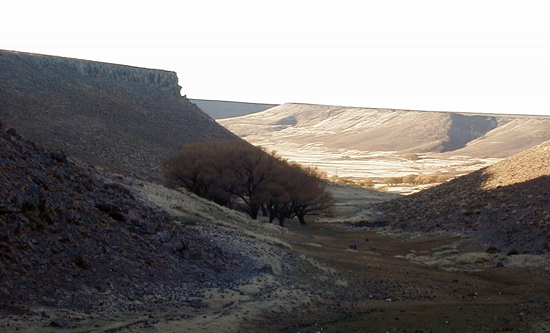The Patagonia Plateau See map
In the Patagonian soil it were found the oldest remains and impressive dinosaurs. The agricultural, livestock, oil and gas economy is strong, but tourism it's worth to do between their ranches, farms and, of course, fossil beds.
 The Bajo de Vaca Lauquen in the rural area of southern Maquinchao. You can see the typical plateu of this region, where there are cave paintings of 4,000 years approx. Photo courtesy of Javier Llancapan.
The Bajo de Vaca Lauquen in the rural area of southern Maquinchao. You can see the typical plateu of this region, where there are cave paintings of 4,000 years approx. Photo courtesy of Javier Llancapan.
This is about the plateau, that geography, that unlike the mountain and the sea, is not present in any other region of the country and marks the boundary between what is Patagonia and what is the humid Pampas.
The Plateau is a large expanse of land that lies between the mountains and the coast of the Patagonian provinces. This will include the towns of the south line of Río Negro as Ingeniero Jacobacci, Maquinchao and Los Menucos, all near the Somuncurá Plateau.
In Chubut stands the city of Sarmiento, in south-central province, whose main attraction is the José Ormachea Petrified Forest. In Santa Cruz we can mention Pico Truncado on the northeast, a typically oil town.
In Neuquén you must clarify that the plateau is located between the mountains and the valley, because this province has no coastline. So we can mention places like Zapala, Cutral Có, Plaza Huincul, Arroyito, El Chocón and El Sauce, among others.
Viajes por la Patagonia
Related Articles
© Patagonia.com.ar 2025 | Todos los derechos reservados.
